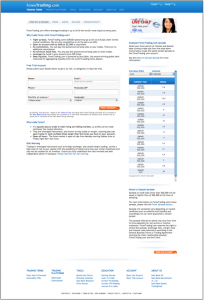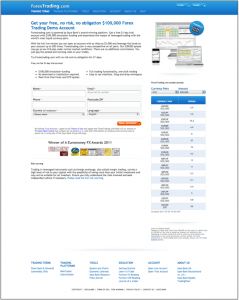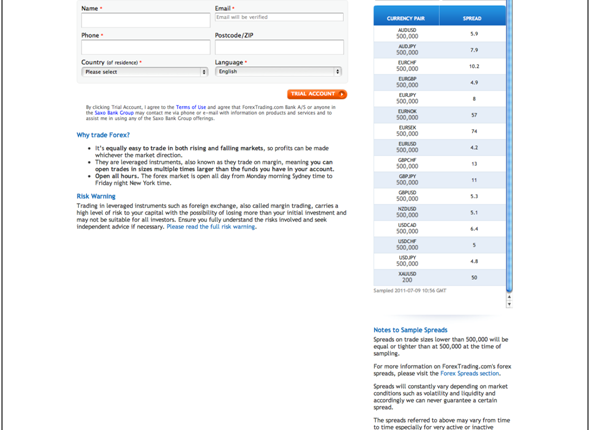Converting PPC Traffic: How clarifying value generated 99.4% more conversions on a PPC landing page
On Monday, we showed you two landing pages and asked you to vote for which one received the highest conversion rate in a split test. The actual test was done by Michael Aagaard, and there was a very clear winner.
In today’s post, I’m going to talk about how Michael got his results. First, the test …
Background
As I mentioned in Monday’s post, this test was for a free trial of a forex trading platform from Denmark’s Saxo Bank. After trying a few different strategies with their page, nothing worked to improve conversion on their PPC landing page for the trial. They had essentially hit a wall with their page. Unfortunately, the money they were making from the product was looking fairly bleak compared to the amount they were spending on PPC.
So when Michael Aagaard offered them a landing page audit through his consulting site, Saxo Bank was willing to give him a try.
Control
By analyzing the control, Michael observed that the page’s value exchange wasn’t clear. The offer itself was a full-featured free trial of Saxo Bank’s award-winning platform. However, there’s no mention of a free trial until the second sub-headline.
The page also contained a considerable amount of friction in the top navigation (where people could click away from the page), and in the multiple calls-to-action.
–

–
Treatment
After hypothesizing that increasing the perceived value on the page, and minimizing the friction, could increase conversion, Michael developed the following treatment.

Results
After a simple split test using Google Adwords’ relatively new Campaign Experiments feature, the results came in …
–

–
What you need to understand
By clarifying the value on the page and communicating a reason to download the free-trial software, Michael was able to raise page conversion by almost 100%, and reduce the cost-per-conversion by 48.2%.
Why was the treatment twice as effective?
Of course, it’s one thing to give you a quick overview of the test, but it’s something else entirely to give you how Michael did it. And who better to tell you how, than Michael himself? Below is a quick, three-question interview with Michael that gives you a better picture into the test’s details.
Paul Cheney: Can you give us a quick overview of what you did to generate such a dramatic lift?
Michael Aagaard: In this case, the main issue with the control was the lack of a clear value proposition. This led to friction, lack of continuity in the marketing messaging, anxiety, and general misinterpretation. By:
- crafting a clear value prop
- presenting it in a clear headline
- and using the body copy to elaborate on it,
we were able to give prospects a very valid and credible reason to go ahead and download the demo.
We implemented just two images. One was a relevant picture to visually support the value prop. The other was a series of award badges that served as a third-party validation to reduce anxiety.
This test is yet another case study indicating that a clear value prop is at the core of all successful online marketing. Everything ties into your main offer, and how clearly you can present its value to the prospect.–
PC: What can our audience learn from your test? What actionable advice/transferable principles can they take away from this?
MA: You need to be acutely aware of the motivations of your prospects and ensure continuity in your messaging throughout the path from lead to conversion. Moreover, it’s critical to have a powerful value prop that clearly answers the question: “Why should I choose you instead of your competitors?”–
PC: Can you tell us a little about the advantages of the testing approach vs. the idea of using best practices to optimize a webpage?
MA: To me, “best practice” is just another way of saying “I’m doing what everyone else is doing.” It’s basically just a standardized set of hypotheses that have been commonly accepted as the undeniable truth – and practically no one bothers to question whether they actually work.
There’s nothing scientific about following rules and “best practices.”
Imagine if Columbus had followed best practices – he’d have never gotten on that ship! He would just have said “Are you insane? The world is flat, you idiot! Do I look suicidal to you?” The same goes for Darwin. Had he listened to the rules, he would never have dared to come up with something as controversial as The Origin of Species.
P.S. Thanks to everyone who voted in the comments for the winning treatment from Monday’s post. The more studious among you may note that I actually switched the order of the control and treatment in Monday’s post to level the playing field a bit. So, those of you who chose Landing Page A in Monday’s post actually voted for the winning treatment.
Congratulations to Valentina for guessing the correct landing page with the closest relative difference in the two treatments.
Related Resources:
landingpages.nu – Michael’s landing page optimization consultancy
ForexTrading.com – Saxo Bank’s forex trading platform
Powerful Value Propositions: How to Optimize this Critical Marketing Element – and Lift Your Results




Thank you Paul. This blog is always super helpful for me and I’ll stay tuned to see what’s next
Congrats to Michael for being featured in a Marketing Experiments blog-post. I know you love these guys as much as I do. So big thanks to Paul for featuring a test from Michael, who is no doubt among the elite in Denmark.
Cheers – Janus – A fellow Dane…
Hi Janus – thank you for the kind words!
And thank you Paul and Marketing Experiments for featuring me on the blog!
– Michael